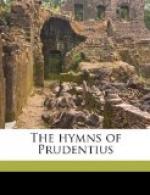not only in an actual sarcophagus or stone coffin, as expressly
mentioned in the text, but in hollow places cut out of rock or
earth (loculus). The sarcophagus method seems to have been the
earlier, but was superseded by that of the loculus, except in the
case of the very wealthy.
205 The concluding line is beautifully illustrated
by the epitaph
on the martyr Alexander,
found over one of the graves in the cemetery
of Callixtus in the
Catacombs:—
ALEXANDER MORTVVS NON EST
SED VIVIT
SVPER ASTRA ET CORPVS IN HOC TVMVLO
QVIESCIT ...
“Alexander is not dead,
but lives above the stars
and his body rests in this tomb.”
IV
15 Prudentius here, as again in v. 160, emphasises
his belief in
the procession of the
Holy Ghost from the Father and the Son. The
“filioque”
clause was not actually added to the Nicene Creed till
the Council of Toledo
(589 A.D.), but the doctrine was expressly
maintained by Augustine,
and occurs in a Confession of Faith of an
earlier Synod of Toledo
(447 A.D.?), and in the words of Leo I.
(Ep. ad Turib.,
c. 1), “de utroque processit.” The
addition
was not embodied into
the Creed as used at Rome as late as the
beginning of the ninth
century. (Vid. Harnack, Hist. of Dogma,
iv. 132.) Prudentius
probably followed, as regards the Trinity,
the doctrine generally
held by the Spanish Church of his day; in
many points it is difficult
(cf. note on iii. 2), but appears to be
derived partly from
Tertullian and partly from Marcellus.
59 The identification of the Habakkuk of this
legend (vid. the
Apocryphal “Bel
and the Dragon”) with the O. T. prophet is erroneous.
This version of the
story of Daniel is sometimes represented in the
frescoes of the Catacombs,
where the subject is a very favourite
one, as is natural in
an age when the cry “Christiani ad leones”
so often rang through
the streets of Rome.
V
1 There has been much doubt as to the title and
scope of this hymn.
Some early editors (e.g.,
Fabricius and Arevalus) adopt the title
“ad incensum
cerei Paschalis,” or “de novo lumine
Paschalis
Sabbati,”
and confine its object to the ceremonial of Easter
Eve,
which is specially alluded
to in ll. 125 et seq. Others, following
the best MSS., give
the simpler title used in this text, and regard
it as a hymn for daily
use. This view is supported by the weight
of evidence: the
position of the hymn among the first six (none of
which are for special
days), and the fact that the Benediction of
the Paschal Candle was




